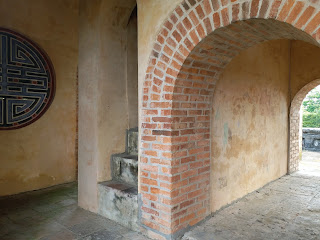Huế in 48 hours was not enough time. So much work has been undertaken in the past decade, and the formerly diminished imperial city is extensive. Another change is the thriving nightlife. Visitors used to be able to take an evening dinner cruise on a small houseboat or peruse the local night market but now there are blocks of streets closed in the evening for pedestrian traffic, lined with bars and clubs. With all of the new developments, Huế's Perfume River still remains the center of life, used for tourism and commerce, feeding water to farms, transporting goods, and winding past ancient monuments and thriving, modern markets.

Parking at the riverfront might market

One of the discos luring in tourists

Three stories of beer
During the day, we enjoyed visiting seemingly endless choices of monuments. One especially famous one is the Thien Mu Pagoda, dedicated to the manushi buddha (a buddha that appeared in human form). Within the temple behind the pagoda is a display featuring the Austin Westminster sedan that carried Thích Quảng Đức to the site of his self-immolation to protest the regime of Ngô Đình Diệm in 1963. The photograph of the act, immortalized by Malcolm Browne who earned a Pulitzer Prize, is still powerful a half century later.

Thien Mu (Pagoda of the Celestial Lady )

We enjoyed a boat ride on the Perfume River, which has been the artery of Huế in different ways for many lifetimes. The river winds past the centuries old tombs and citadels of ancient rulers, serves as a conduit of trade as it did for many centuries, and now ferries tourists, the new life blood of the city.


SB, his sister, niece, and I also spent a morning wandering alone at the city walls. Most of the tourists go straight to the good stuff in the center but there is much to see where the old walls interface with the vibrant city. It is amazing to me how in this place, people live like they do in Rome, immersed with the ruins and glorious past.



Parking at the riverfront might market

One of the discos luring in tourists

Three stories of beer
During the day, we enjoyed visiting seemingly endless choices of monuments. One especially famous one is the Thien Mu Pagoda, dedicated to the manushi buddha (a buddha that appeared in human form). Within the temple behind the pagoda is a display featuring the Austin Westminster sedan that carried Thích Quảng Đức to the site of his self-immolation to protest the regime of Ngô Đình Diệm in 1963. The photograph of the act, immortalized by Malcolm Browne who earned a Pulitzer Prize, is still powerful a half century later.

Thien Mu (Pagoda of the Celestial Lady )

We enjoyed a boat ride on the Perfume River, which has been the artery of Huế in different ways for many lifetimes. The river winds past the centuries old tombs and citadels of ancient rulers, serves as a conduit of trade as it did for many centuries, and now ferries tourists, the new life blood of the city.


SB, his sister, niece, and I also spent a morning wandering alone at the city walls. Most of the tourists go straight to the good stuff in the center but there is much to see where the old walls interface with the vibrant city. It is amazing to me how in this place, people live like they do in Rome, immersed with the ruins and glorious past.


Comments